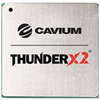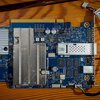Thanks to the discovery of the Higgs boson in 2012, CERNs Large Hadron Collider (LHC) has probably become the most widely recognized science project on the planet. Less well-known is the computing infrastructure that supports this effort and the demands that are placed upon it.
Cavium has released the ThunderX2 processor for general availability, paving the way for the first generation of ARM-powered high performance computing.
At the Microsoft Build conference on Monday, the company kicked off a new cloud offering that would provide machine learning resources to cloud customers using Intel FPGA-accelerated servers.
Episode 221: Addison Snell and Michael Feldman analyze the DOE's exascale whole-earth model announcement and the UK's AI initiative.
Italian multinational Eni is putting its new HPC4 supercomputer to good use, using all 3,200 of the systems GPUs to run 100,000 oil reservoir simulations in record time.
Dell EMC has launched the PowerEdge R840 and R940xa, two new four-socket servers that offer GPU and FPGA coprocessors for accelerating machine learning, analytics, and other data-intensive workloads.
The Pawsey Supercomputing Centre announced that the Australian government is investing $70 million in the center to replace its aging supercomputers.
Google has announced it isoffering NVIDIA Tesla V100 GPUs for its HPC and machine learning cloud customers.But how willthe company square this with its TPU cloud offering?
The British government and the private sector are investing close to 1 billion pounds to boost the countrys artificial intelligence sector. The investment, which was announced on Thursday, is part of a wide-ranging strategy to make the UK a global leader in AI and big data.
Research university KU Leuven has installed a new HPE supercomputer designed to run artificial intelligence workloads.









